People say that those with large foreheads are extremely smart. They have many abilities and can complete any job they receive well ahead of time.
When it comes to animals with big foreheads, the situation is completely different.
Although head-to-body ratio (or brain-to-body ratio) can indicate intelligence, animal brows can serve different purposes – to hit other animals with them, to amaze people with their extravagant looks, and to have people make funny memes of their huge heads.
Examples of animals with big foreheads include the beluga whale, several types of fish like the Napoleon fish, Midas cichlid, bison, elephants, koalas, and many others.
Here are the 15 most interesting animals that have big foreheads compared to their overall head size.
Table of Contents
Animals With Big Foreheads
Beluga Whale

Size: 13–16 ft (3.9–4.9 m)
Weight: 1,500–3,500 lb (700–1,600 kg)
Lifespan: 35-50 years
Habitat: Coastal waters of Alaska, USA, Canada, Greenland, Norway, Russia
Our list can’t start without the master of the biggest foreheads in the animal world, the beluga whale. They are easy to recognize by their white color and globular head.
Fun fact though: belugas are born dark gray and after 8 years become white. Despite living in water, they are mammals, not fish.
The rounded forehead is called a “melon” and a beluga whale can change its shape by blowing air through its sinuses. These animals use their big forehead to sense vibrations in the water.
Belugas feed on fish, crustaceans, and worms and can dive to the sea bottom, in areas deeper than 3,300 ft (1,000 m). They can remain submerged for 25 minutes.
Napoleon Fish (Humphead Wrasse)
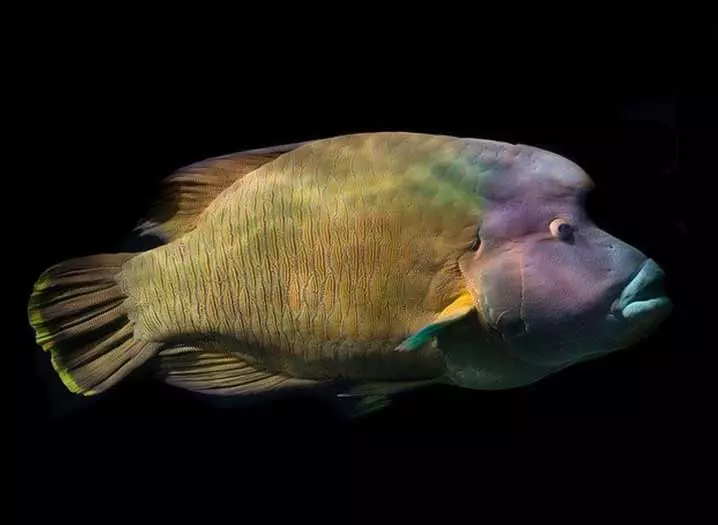
Size: 6 ft (182 cm)
Weight: 420 pounds (191 kg)
Lifespan: 30 years
Habitat: Indo-Pacific oceans
Napoleon fish (humphead wrasse) can be easily recognized by their size, color, and forehead shape. They get their name from the distinctive hump on their forehead, which resembles the hat of the French emperor Napoleon Bonaparte.
Their head hump becomes more prominent as they get older.
What makes them interesting is that they can switch their sexes. Napoleon fish are born with both male and female sex organs and if a dominant male dies, a larger female will turn into a male to ensure the survival of the species.
Green Humphead Parrotfish

Size: 5 ft (100 cm)
Weight: 165 lb (75 kg)
Lifespan: 40 years
Habitat: Reefs in the Indian and Pacific Oceans
The green humphead parrotfish is the largest species of parrotfish. It can grow to lengths of 5 ft (100 cm) and weigh up to 165 lb (75 kg). They are similar to Napoleonfish, but they are not the same species.
What makes green humphead parrotfish differ from other parrotfish is their large size, appearance, diet, and by their ecological impact on coral reef ecosystems. They are very easy to spot in water because of the huge bump on their head.
Humphead parrotfish eat algae from reef-building corals and by doing so they help maintain a healthy and more diverse coral reef ecosystem.
Midas Cichlid
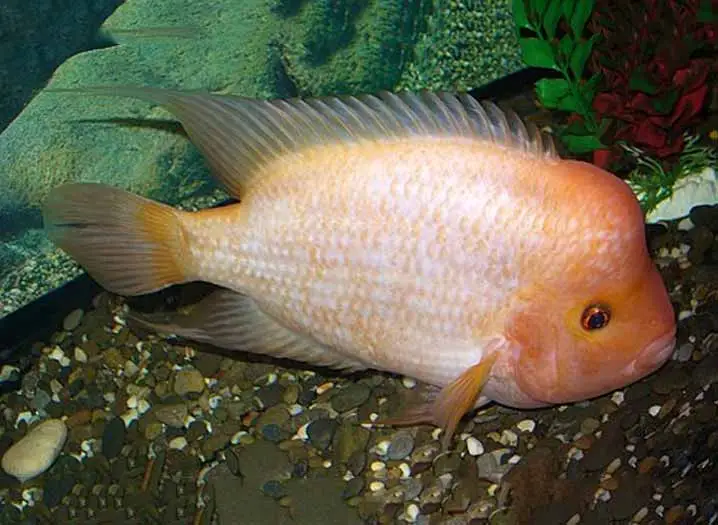
Size: 14 in (35.5 cm)
Weight: 2.5 lb (1.1 kg)
Lifespan: 10-12
Habitat: USA, Central America
Another fish with a big forehead is the Midas cichlid. They are easy to recognize by their golden color and lumps on their heads which are known as a ‘nuchal hump’. Only adult fish have it.
They live in calm waters at depths between 3 and 114 ft (0.91-34.7 m) and feed on small fish, worms, snails, and algae.
Other fish with big bumps on their forehead is the humphead glassfish (humphead perchlet) and hump-headed blenny.
Read more: 7 fish species with huge foreheads
Chihuahua

Size: 6-9 in (15-23 cm)
Weight: 2-6 lb (0.9-2.7 kg)
Lifespan: 12-20 years
Habitat: Mostly indoor
Our first land animal with a big forehead (compared to its head size) has to be a chihuahua. This cute and funny-looking animal has a small head and a forehead that stands out.
A small head does not make them any less intelligent. In fact, chihuahuas are some of the most intelligent and loyal breeds of dogs. They got their name from the Mexican state of Chihuahua, where the breed originated.
Here’s a fun fact: you’re most likely pronouncing their name wrong.
If you say their name similar to “Chuh-wow-wowa”, you should know that the true pronunciation is more like “Shee-wa-wa.”
And we can’t talk about chihuahuas without mentioning the old and famous chihuahua song. Good luck in getting that out of your head!
Orangutan
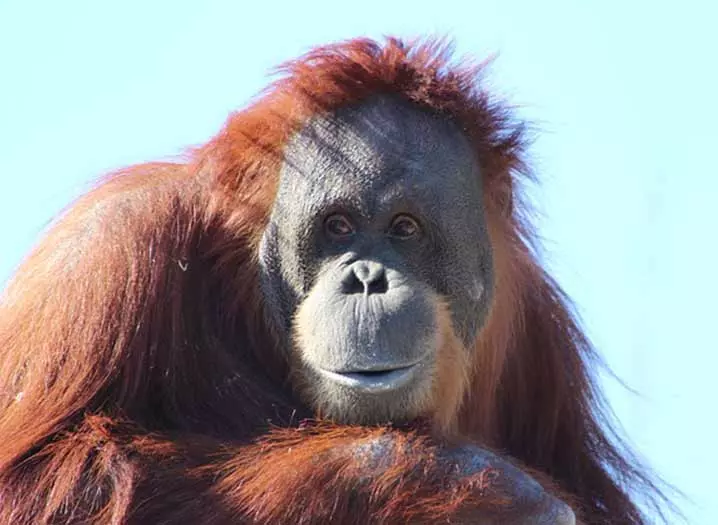
Size: 4 ft 6 in (137 cm)
Weight: 165 lb (75 kg)
Lifespan: 35-45 years
Habitat: Rainforests of Borneo and Sumatra
The heaviest tree-dwelling animal, orangutans, also have admirable forehead sizes. This is especially noticeable in younger apes.
Males can develop thick cheekpads that make their heads stand out. This makes their forehead less noticeable. Maybe they do that on purpose, to hide their excessively prominent brows? 🙂
After they develop their fatty face cheeks, orangutans will become very aggressive towards other males that come close to them or their females.
They are also our closest relatives – we share almost 97% of the same DNA with them.
The word orangutan comes from the Malay words “orang hutan“, meaning “human of the forest“.
Bald Uakari
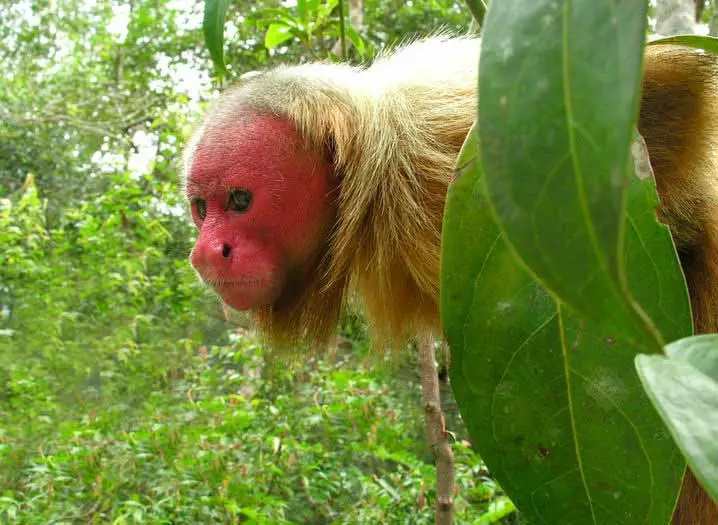
Size: 14-22.5 in (35-57 cm)
Weight: 6.1-7.6 lb (2.75-3.45 kg)
Lifespan: 30 years
Habitat: Amazon River basin
Next is another monkey with an interesting-looking face.
Bald uakaris or bald-headed uakaris are small South American monkeys with very short tails, striking bald heads, and bright red faces.
Their name is pronounced as ‘wakari’ and although their face might look weird, that’s how they attract mates – monkeys with the reddest faces are the most attractive ones.
They have very strong jaws and sharp teeth that can crack tough nuts, which other monkeys might not do.
Gorilla
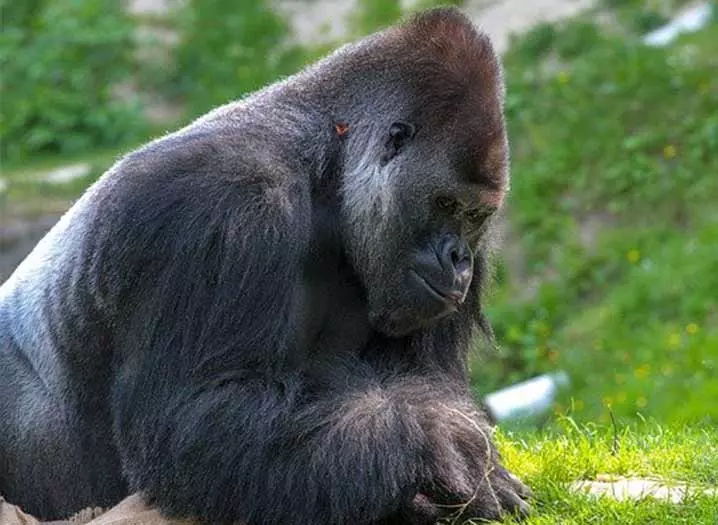
Size: 5.5 ft (1.7 m)
Weight: 300–485 lb (135-220 kg)
Lifespan: 35-40 years
Habitat: tropical forests of Africa
Another monkey with a large and highly intellectual forehead is the gorilla. It is the largest species of primates and an endangered species – there are around 1,000 of them in existence.
According to Scientific American journal, we share around 98% of our DNA with them – only the chimpanzees share more DNA with us, around 99%.
Read More: Will a gorilla burp when it’s happy?
Proboscis Monkey

Size: 26-30 in (66-76.2 cm)
Weight: 35-50 lb (16-22.5 kg)
Lifespan: 20-30 years
Habitat: Borneo
Known as the monkey with a big nose and prominent forehead and shoulders, the proboscis monkey is quite a unique animal.
At first, you might not notice their foreheads because of their noses, but proboscis monkeys tawny-red fur patch on the forehead that resembles a unibrow.
With a protruding belly and the largest nose of any primate, the proboscis monkey is the world’s world’s most prolific swimmer and can be frequently seen leaping from tree limbs and hitting the water with a comical belly flop.
This monkey has webbed toes that enable it to swim long distances.
Proboscis monkey is an endangered species with a population of around 7,000 individuals in existence today.
Elephant

Size: 8.2-13 ft (2.5-4 m)
Weight: 14,000 lb (6,350 kg)
Lifespan: 50-70 years
Habitat: Sub-Saharan Africa, South Asia, and Southeast Asia
Elephants are the largest land mammals with large trunks, tusks, and a huge temple area on their heads. They can weigh up to 14,000 pounds (6,350 kg) and can carry 19,800 pounds (9,000kg)- their trunk alone weighs around 400 pounds!
They can communicate via vibrations on the ground which others detect through their bones.
Despite their enormous size, African elephants can run at speeds of up to 25 mph (40 km/h).
Want to learn who would win in a race between a camel and an elephant? Read this article. Scroll down a bit to get to their comparison in that article.
Read more: Animals that resemble anteaters
Kamfa

Scientific Name: /
Size: 4.5-5 in
Weight: 1 lb
Habitat: Thailand
Kamfa is a freshwater fish with a big forehead.
It is a flowerhorn fish, a freshwater hybrid that was produced by crossing several different types of fish. Because it was artificially bred by humans, it does not have a scientific name and is not recognized as distinct species.
Kamfa is characterized by a body shape that is square, white, or yellow eyes, and a huge bump on its head that looks like a forehead.
Kamfas are omnivores and feed on shrimp, worms, insects, and plant matter. They are often mistaken for another type of flowerhorn fish, the Zhen Zhu.
Dolphinfish
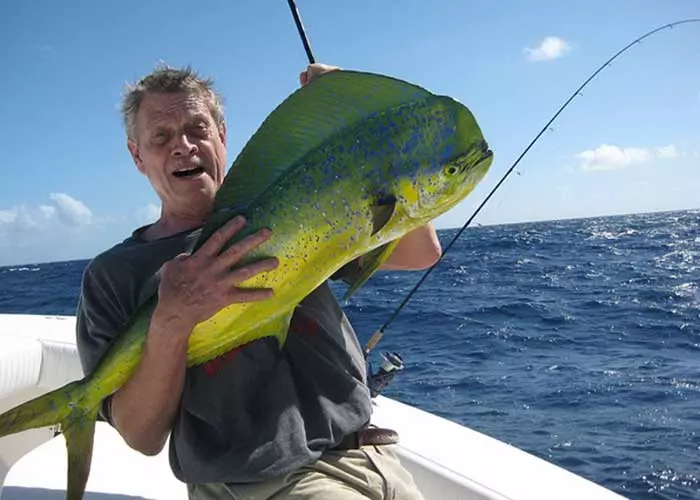
Scientific Name: Coryphaena hippurus
Size: 2.8-4.6 ft
Weight: 49 lb
Habitat: Atlantic, Indian, and Pacific ocean
Dolphinfish, also known as mahi-mahi, is an ocean fish with a big forehead. It is colorful, with a large body, blunt face, forked tail fin, and a distinctive shape of its forehead. The name mahi-mahi means “strong strong” in Polynesian.
They are very fast swimmers that can reach speeds of up to 60 mph. Larger dolphinfish males have high, vertical foreheads, while females have rounded ones.
The best time to target mahi-mahi in Florida is from April through June.
Oranda

Scientific Name: Carassius auratus auratus
Size: 8-12 in
Weight: n/a
Habitat: China
Oranda is a breed of goldfish that has a characteristical bubble-like “hood” on the head that looks like a big forehead. It has a tall tail fin, it is one of the friendliest species of fish and an omnivore.
Oranda can live up to 15 years. One variation of oranda, the red-cap oranda, has a silver body color and a red head growth on the forehead that looks like a raspberry.
Another member of orandas, the black goldfish, is a characteristically black fish with a big forehead.
American Bison
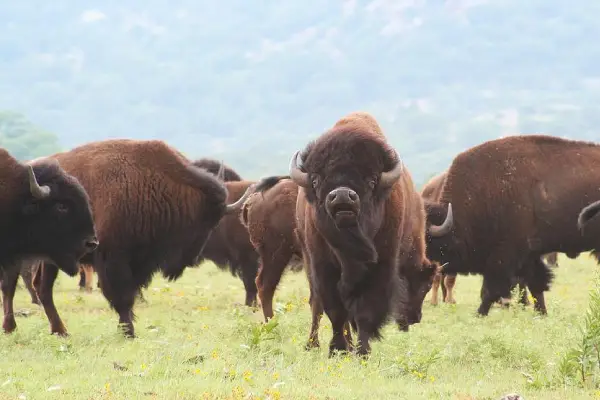
Size: 9.3 ft (2.8 m)
Weight: 701-2,599 lb (318-1,179 kg)
Lifespan: 10-20 years
Habitat: North America
Native to North America, the American bison is one the heaviest animals with big foreheads in North America. It is a massive shaggy beast that is iconic in the Great Plains and the Old West.
American bison have characteristical humps over the front shoulders and slimmer hindquarters. Resting low on their short, stocky necks, the bulky head has a broad forehead and short, up-curving horns. The thick fur on the male’s forehead reduces the impact of the head clashing with other males.
Although superficially similar, the American and European bison are quite different.
They were once close to extinction with only around 325 remaining in 1884.
The only place in the US where American bison have continuously lived since prehistoric times is Yellowstone National Park.
Read More: Animals that have the brown color of their fur
Koala

Size: 2-3 ft (60-85 cm)
Weight: 9–33 lb (4–15 kg)
Lifespan: 13-18 years
Habitat: Australia (Queensland, New South Wales, Victoria, and South Australia)
The final animal on our big-forehead list is the koala. It is one of Australia’s most famous and cutest animals. Koala is well-known for its large round head, big furry ears, and big black nose.
People might call them “koala bears”, but they are marsupials (animals like opossums, Tasmanian devils, kangaroos, wombats, etc.).
They are many people’s spiritual animals because they sleep 18 hours a day and look for juicy eucalyptus leaves to munch on all day.
Did you know that there are over 20 animals that look like groundhogs? See how they look here.
Final Thoughts
This concludes our article on 15 animals with big foreheads.
The most popular land animals with big frons are chihuahuas, apes like orangutans, gorillas, bald uakaris, elephants, and koalas. All of these animals have characteristically large foreheads.
When it comes to fish that have big head brows the most famous ones are the Napoleonfish, Green humphead parrotfish, and the Midas cichlid. Another water creature with a big hump on its head is the beluga whale.
Photo Sources
Green Humphead Parrotfish – Muñoz RC, Zgliczynski BJ, Laughlin JL, Teer BZ, CC0, via Wikimedia Commons
Midas Cichlid – George Chernilevsky, Public domain, via Wikimedia Commons
Red Uakari – en, Public domain, via Wikimedia Commons